2025/03/21Number of reading(44974)Number of comments(0)
一、Target Audience
Operators
二、Feature Introduction
Advertising search terms are the words that customers enter into the Amazon search box or browse, which match our ads. They can be keywords or product ASINs, and are generally highly relevant to our products. They reflect buyers' real search habits and are an important data source for optimizing ad keywords, listing keywords, and competitor targeting.
After running ads for a period of time, you can download search term reports for Sponsored Brands (SB) and Sponsored Products (SP) ads for different time periods from Amazon Seller Central. You can then use Excel spreadsheets to filter out high-quality keywords related to your products. However, using Excel spreadsheets for organization and analysis, downloading and merging data, and filtering is often inconvenient.
SellerSpace's 【Search Term】 feature easily solves this problem. Through the official Amazon API, it automatically integrates search term report data from your Seller Central account for Sponsored Brands (SB) and Sponsored Products (SP) ads. This helps sellers efficiently analyze search term data, understand advertising performance, and identify high-performing keywords. These keywords can then be used for product listing optimization and campaign retargeting, driving more precise and profitable sales.
三、Synchronization Frequency
1. Approximately 2-3 hours after successful authorization, advertising data from the last 60 days will be automatically synchronized, and data will be updated approximately every 30-60 minutes.
2. After the data synchronization for the last 60 days is completed, advertising data from the last 2 days will be updated approximately every 30-60 minutes, and advertising data from the last 3-60 days will be updated once a day, referring to the Amazon advertising attribution window.
3. If you authorize the store first and then enable Amazon Advertising, you may encounter a situation where advertising data cannot be found. At this time, you need to manually refresh the advertising data by clicking the 【Latest Update】 button. You can also view the latest update time of the advertising data.
 +
+
四、Use Cases
- Analyze the campaign performance of ad groups, such as: expanding the number of search terms, and the performance of corresponding terms, etc.
- Analyze the relevance of keywords embedded in product listings through automatic campaign derived terms.
- Filter out relevant high-quality search terms that are not yet targeted in ads, run manual campaigns, and get more precise sales.
- Easily target keywords not yet added to ads, and one-click negate poorly performing search terms.
- Quickly identify accurate high-frequency root search terms by analyzing word frequency.
五、Operation Guide
We can use the search term feature to analyze advertising performance, including: which ad the search term comes from, what match type, search impression rank and share, etc. After analysis, it supports directly adding the filtered search terms to ad targeting or negative targeting.
1. How to View Search Terms
1.1 Search Bar
We can view and analyze advertising search terms from multiple dimensions through the search bar. For example: time dimension, ad portfolio, ad type, ad campaign, ad group, search term type, match type, single search term, etc. Each filter dimension can be freely combined to suit different viewing and analysis needs.
 +
+
1.2 Analysis
In addition to the above dimensions, we can also filter different advertising metric performances to find the target search terms we are looking for. For example: order quantity range, impression range, CPC range, etc.
Click the 【Analysis】 button to enter filtering.
 +
+
Filter according to different metric conditions:
 +
+
1.3 Customize Columns
Every seller has their own analysis patterns, and the metrics they value are also different. Therefore, in order to match each seller's analysis habits, we have launched the 【Customize Columns】 feature. Sellers can customize the metrics for sorting advertising keywords according to their own analysis habits, and support ascending and descending order display of metrics.
Click the 【Customize Columns】 button to enter settings.
 +
+
Enter the "Customize Columns" settings page,
We can click and hold the metric with the mouse and drag it up and down to sort it;
You can also enable or disable the display of a certain metric by clicking the 【Enable/Pause】 button on the right;
When there are too many metrics, you can perform "inverse selection", select the smaller part, and click the 【Inverse Selection】 button above;
If the settings are wrong, click 【Restore】 to return to the state when setting and reset;
After setting, click 【Confirm】 to save the customized column settings.
 +
+
1.4 Quick Query
When we have filtered the viewing dimensions and will frequently view the data under this dimension in the future, we can save it as a quick query, which is convenient for us to filter with one click next time, saving time.
After filtering the conditions, click 【Save Current Query】 to enter the adding page.
 +
+
Enter the "Add My Quick Query" page,
Select the applicable site, enter the quick query name, and save with one click.
 +
+
After saving, in 【My Quick Query】, you can set it to the homepage search bar, and then you can query the search term data under this dimension with one click.
Operation method is as follows:
Hover the mouse over the 【My Quick Query】 button to see all quick query modes.
Find the quick query that needs to be fixed to the search bar and enable fixing.
 +
+
After fixing, it will be displayed in the search bar. Click it to search.
 +
+
If we want to query data of a certain dimension all the time, we can also set it as 【Default Query】. After setting, when you enter search terms, data under this dimension will be automatically filtered.
Hover the mouse over 【My Quick Query】, find the quick query to be set, and enable 【Default Query】.
 +
+
We can add multiple quick queries, and also support deleting unnecessary quick queries or modifying quick query names.
Hover the mouse over 【My Quick Query】, find the corresponding quick query, and delete or modify the name.
 +
+
There are three recommended quick query dimensions in the system, which cannot be adjusted.
 +
+
1.5 Total Chart
In addition to filtering, viewing, and analyzing the data of synchronized advertising search terms, we can also integrate these data from different dimensions to help us quickly grasp the real performance of keywords to which search terms belong and quickly optimize campaign decisions.
The "Total Chart" feature is one of them. The "Total Chart" summarizes and statistically analyzes the core metric performance of search terms and displays it in two forms: charts/tables, which can help us quickly grasp the recent performance trends of advertising keywords.
Core metrics include: CPC, ROAS, Impressions, Clicks, Advertising Sales, Advertising Orders, CTR, ACOS, Advertising Spend
Click the 【Show Chart】 button to view the data of the total chart.
 +
+
Total chart data:
 +
+
The data time range of the total chart is consistent with the time range of the query bar, and changes with its settings.
 +
+
The system displays all core metrics by default. We can also set which metrics to display by default.
Click the 【Default Metrics】 button in the upper right corner to enter the settings page.
 +
+
Enter the "Default Metrics" settings page,
- We can click and hold the corresponding metric with the mouse and drag it up and down to sort it;
- You can also enable or disable the display of a certain metric by clicking the 【Enable/Pause】 button on the right. At the same time, you can select all or deselect all;
- When there are too many metrics, you can perform "inverse selection", enable or disable the smaller part, and click the 【Inverse Selection】 button above;
- Set different display methods for metrics: bar chart/line chart. If you choose a line chart, you can further choose solid line, dashed line, dotted dashed line;
- You can also set the display color for metrics. Colors can be selected from preset color codes or custom color codes;
- If the settings are wrong, click 【Restore】 to return to the state when setting and reset;
After setting, click 【Confirm】 to save the settings.
 +
+
After setting, the corresponding metric data and colors will be displayed above the chart homepage.
If one screen cannot display all, click the 【Expand】 button on the right to display all.
 +
+
Individual metrics can also be set separately.
Click the small eye icon to view the metric separately. Click again to restore to the original state.
 +
+
Click the 【Settings】 button to set the style of the metric separately, including color and display method.
 +
+
Click the 【Delete】 button to cancel the default display of the metric.
 +
+
After confirming the display metrics and methods, we can view the corresponding data trends.
Hover the mouse over the data in the chart to view the specific value of the node.
 +
+
Hover the mouse over the chart line of a certain metric to view the trend chart of only that metric.
 +
+
The system displays 【Total】 data by default. We can also view 【Hourly】 data. "Hourly" here refers to displaying the corresponding metric data by single day.
Click the 【Hourly】 button in the upper left corner to switch with one click.
 +
+
When we view the core data performance trends, we can also combine 【History】 to facilitate us to view which adjustment operations have been made when we see data anomalies, and analyze whether our operations caused them.
Check 【Show History】 to view the recent 100 operation logs in SellerSpace.
 +
+
When viewing operation logs, simple filtering is also supported.
You can directly select the corresponding "Operation Object" and "Operation Type".
 +
+
The viewing of the total chart, in addition to the "Chart" mode, also supports viewing in the form of a "Table".
Click 【Table】 in the upper right corner to switch with one click.
 +
+
Table mode:
 +
+
In the table display form, metrics also support custom sorting.
Click 【Display Order】 in the upper right corner to enter the settings page and drag metrics to sort according to your habits.
 +
+
Finally, the data of the total chart supports export, and the export format is Excel spreadsheet, which is convenient for us to analyze offline.
Click the 【Export】 button in the upper right corner to export with one click.
 +
+
1.6 Existence
We can view whether the buyer search terms matched by ads have been used for advertising, so that we can more easily find high-quality, untargeted keywords to optimize our ads, listing keywords, and get more precise sales.
Moreover, if ads have already been targeted, we can also view whether the search term exists in ad targeting or negative targeting separately, which is convenient for us to quickly analyze data.
Click the 【Existence】 button to enter and view details.
 +
+
Enter the "Existence" details page,
We can see which ad campaign the search term is targeting, targeting status, match type, bid, etc.
 +
+
We can click 【Existence Method】 in the upper left corner to filter and view ads that exist in targeting or negative targeting.
 +
+
Or only view the ad campaign information corresponding to the current search term performance.
Check 【Only view the usage of corresponding ad groups and ad campaigns】 and view with one click.
 +
+
When viewing and analysis is completed, we can directly adjust the bid of the ad here according to the analysis results.
Click the bid amount to adjust with one click.
Explanation:
- When adjusting bids, you can refer to the suggested bid.
- The suggested bids in the SellerSpace system are all Amazon suggested bids obtained through the official Amazon API.
- The suggested bid may be different from the suggested bid seen in Seller Central because the suggested bid will change, and there is a time difference in the data obtained by the API.
 +
+
In addition to viewing "Targeting" and "Negative" existence in the "Existence Details Page", you can also view it directly on the homepage.
Below the "Existence" button, the left side is "Targeting" existence, and the right side is "Negative" existence.
 +
+
If you want to quickly filter out high-quality keywords that do not exist, you can use the search bar to filter the corresponding results according to your needs.
 +
+
1.7 Search Term Performance
Like other advertising feature data, search terms can also analyze their historical performance trends to help us fully understand the quality of the search term and then accurately judge whether the term is usable.
Find the search term to be analyzed, click the history trend button to enter the analysis page,
 +
+
Enter the "Search Term Performance" page,
Search term performance is divided into two analysis dimensions: 【Historical Performance】 and 【Period Comparison】.
Historical Performance
Historical performance shows all historical data of the synchronized ad campaigns.
Its viewing and usage methods are basically similar to 【Total Chart】, such as: setting default display metrics, setting single metrics, hovering over charts to view separately, chart/table display forms, total and hourly display, showing operation logs, exporting, etc.
Total Chart - Picture and Text Tutorial: Click to View
 +
+
There are 2 differences from 【Total Chart】: support for custom time ranges and display data in different time dimensions.
① Support for custom time ranges
The data time range of the historical performance of advertising keywords is consistent with the settings in the query bar by default. However, we can also set other time ranges we want to view separately without setting them in the query bar and then entering to view.
Click the time setting bar in the upper left corner to set it directly. The setting method is consistent with the query bar.
 +
+
② Display data in different time dimensions
After we set the time range, we can choose to view and analyze data in four dimensions: "Day, Week, Weekday, Month" according to the time range.
Click the button on the right side of the time range to switch with one click.
 +
+
1.8 Impression Share and Rank
Impression share and impression rank are exclusive metrics for keyword campaigns. Search term impression share: indicates the percentage of times you won impressions for this search term in the past 30 days.
We can use search term impression share and rank to determine potential keywords to target, which helps us choose keywords to target. Among them, search term rank can also help us understand the activity level of the targeted terms.
 +
+
Click the impression share value to further view the campaign performance of the keyword as a search term in the last 30 days.
 +
+
Campaign performance of search terms in the last 30 days:
 +
+
1.9 Weekly Search Rank
Similar to "Impression Share and Rank", weekly search rank is also a targeted metric data for keyword campaigns.
It refers to the Amazon Brand Analytics data of the keyword in the last 14 days, which is the ABA keyword search frequency rank data.
We can directly view the weekly search rank of the keyword. Red indicates a decrease in performance compared to last week, and green indicates an increase.
Click the trend button next to it to further view its weekly search rank trend to understand historical performance to help us grasp the advertising effect of keywords at a deeper level.
 +
+
Weekly search rank trend of search terms:
 +
+
1.10 Word Frequency Analysis
We can quickly understand the product attributes and search habits that buyers are most concerned about by analyzing the word frequency of search terms.
Statistics on the frequency of the same words appearing in search terms, words are split by spaces. The system displays search terms with 2 words by default. You can click on the left to switch the number of words. Up to 4 words of word frequency statistics are supported.
 +
+
The words with more orders are displayed at the top. Click 【Expand】 on the right to view up to 40 words.
 +
+
In addition to viewing on the homepage, click 【Word Frequency Analysis】 on the right to further view the Amazon search performance of these word frequency words to understand whether they are worth advertising.
 +
+
Word frequency analysis data:
 +
+
1.11 SellerSprite Insight
This is a linked feature with SellerSprite. When we add ad targeting or analyze ad data in SellerSpace, we can directly gain insight into the market relevance, competitiveness, search volume, and purchase volume of user search terms, Amazon suggested keywords, and targeted keywords in SellerSpace, which is convenient for us to quickly decide whether to target and negate.
The SellerSprite Insight feature is mainly distributed in the 【Targeting - Keywords】 and 【Search Term】 features, and "Amazon Suggested Keywords" selected when adding keywords.
Take the use of 【SellerSprite Insight】 in the 【Search Term】 feature as an example.
Enter the homepage of the "Search Term" feature, find the keyword to be insighted, and click 【SellerSprite Insight】 to enter the data page.
 +
+
Enter the "Batch Insight Keywords through SellerSprite" page,
The system displays insight data for the last 30 days by default. We can also choose other months to view and analyze.
Note: Some keywords may not be displayed because they are not included due to low ranking.
 +
+
In the insight data, for the "Monthly Search Trend" data, hover the mouse over the corresponding polyline part to view the specific data of the node.
 +
+
Click the "Monthly Search Volume" value to view the monthly search volume trend of the keyword, including: search trend, Google Trends, click concentration and PPC bid, a total of 4 types of trend data to help us understand the overall market performance of keywords more deeply.
 +
+
The viewing and analysis methods of the four types of trend data are basically the same as all advertising data tables.
Search Trend:
 +
+
Google Trends:
 +
+
Click Concentration:
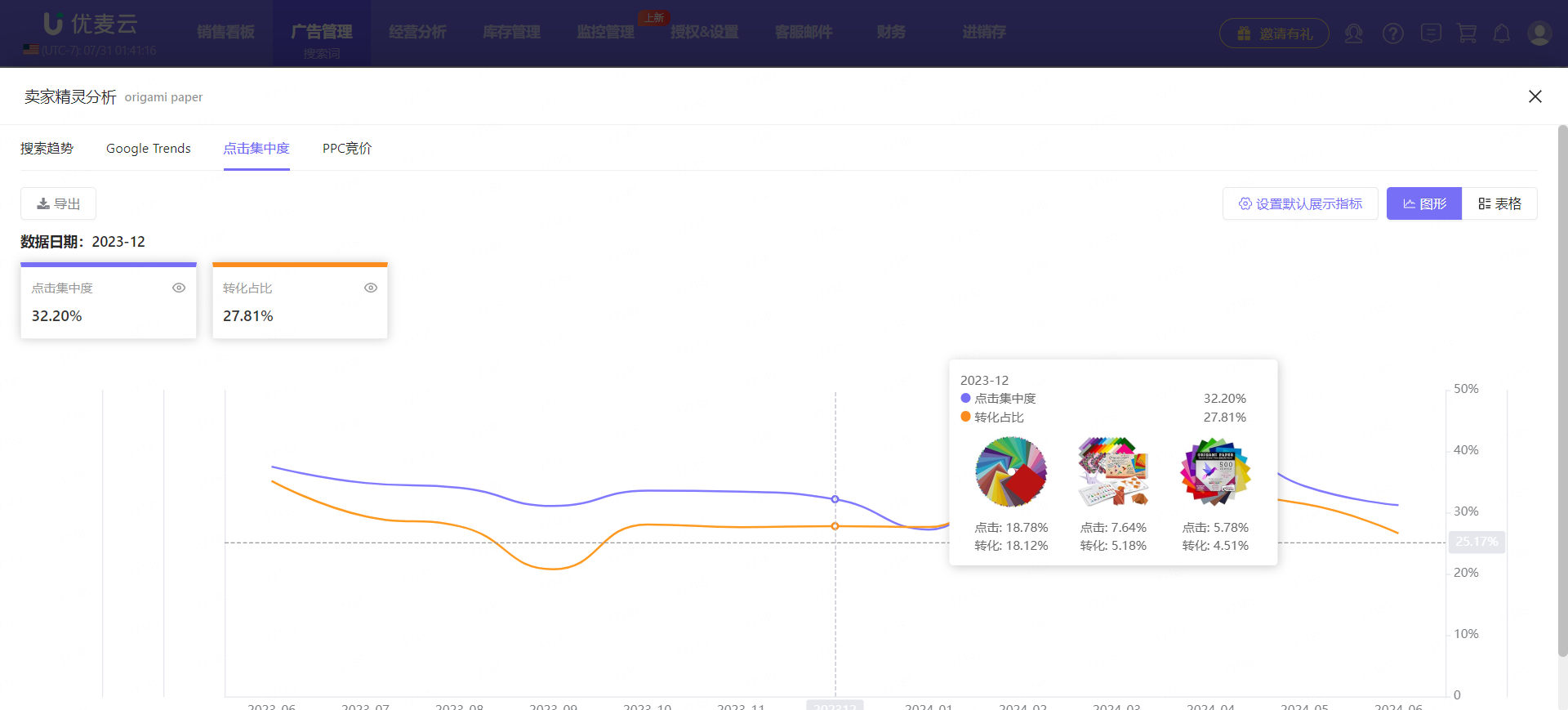 +
+
PPC Bid:
 +
+
When we have analyzed the data of keywords, we can add keywords to different ad groups for targeting or directly negate them.
Check the keywords to be added, and then click 【Add to Keywords】 or 【Add to Negative Keywords】. According to your needs, select the corresponding ad campaign ad group to add.
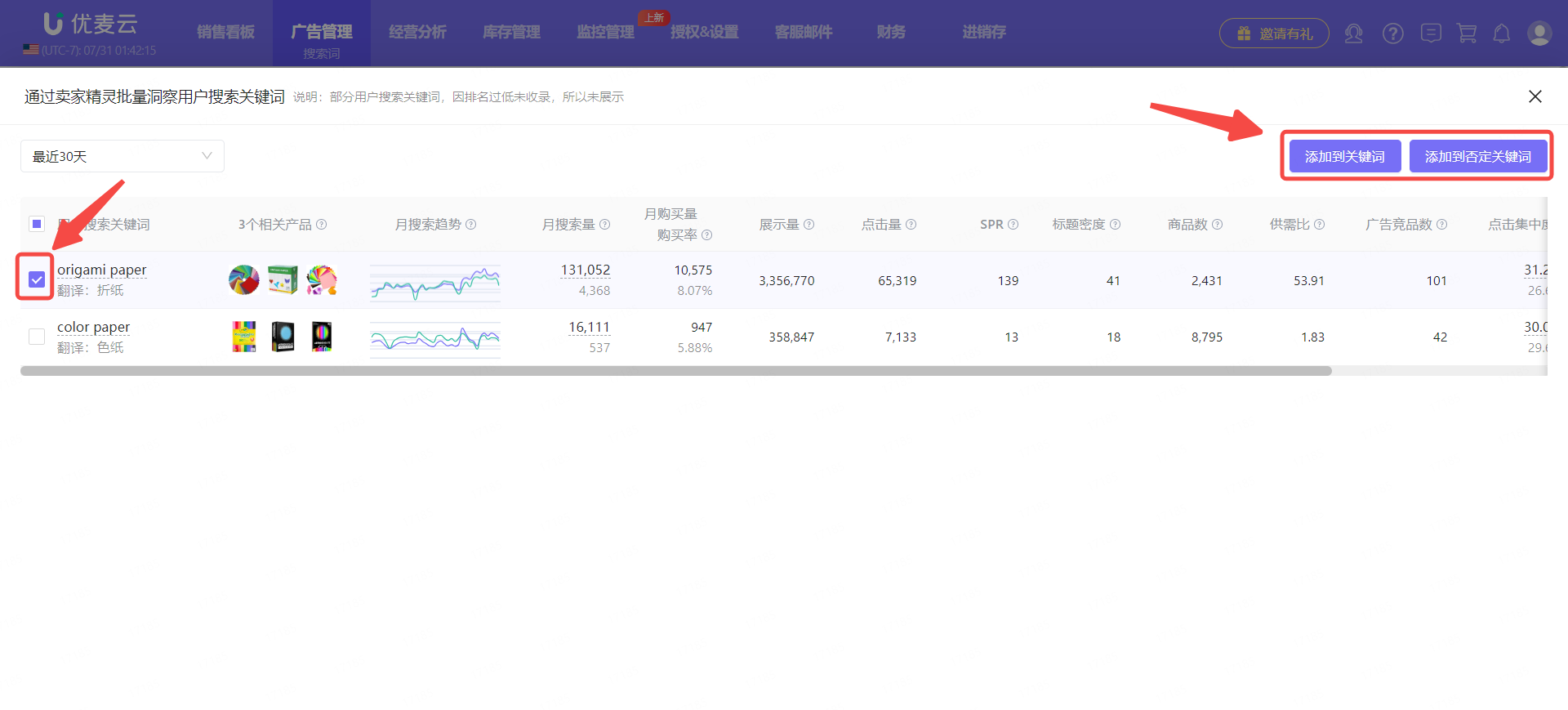 +
+
1.12 Data Comparison
When we usually run ads for a product, we may target multiple keywords for the product, or even target multiple keywords with different match types. At this time, we need to "select the superior and eliminate the inferior" and decide whether to keep or remove them by comparing and analyzing their data.
The 【Data Comparison】 feature can help us compare the core performance data of different advertising keywords, find differences, and discover problems.
We can compare the campaign performance data of multiple keywords.
Find the keywords to be compared, check them, and click 【Data Comparison】 to enter the comparison data pop-up page.
 +
+
Enter the "Data Comparison" page,
First, select the metrics to be compared and viewed.
The metrics for data comparison are the core metrics of ad targeting: ACOS, Clicks, Advertising Spend, CPA, CPC, Advertising Orders, Advertising Sales, CTR, CVR, Impressions, ROAS.
 +
+
Then, select the data time.
We can compare and analyze keyword data for all times synchronized after authorization.
Click the time bar, select the corresponding time range, and support customization. At the same time, according to the length of the selected time range, you can further choose to display data by "Day, Week, Month".
 +
+
After selecting the data time range and metrics, you can directly view the corresponding data.
Hover the mouse over the curve chart to view the specific data of the node.
 +
+
Hover the mouse over the keyword name above to view the corresponding metric performance trend of the keyword separately.
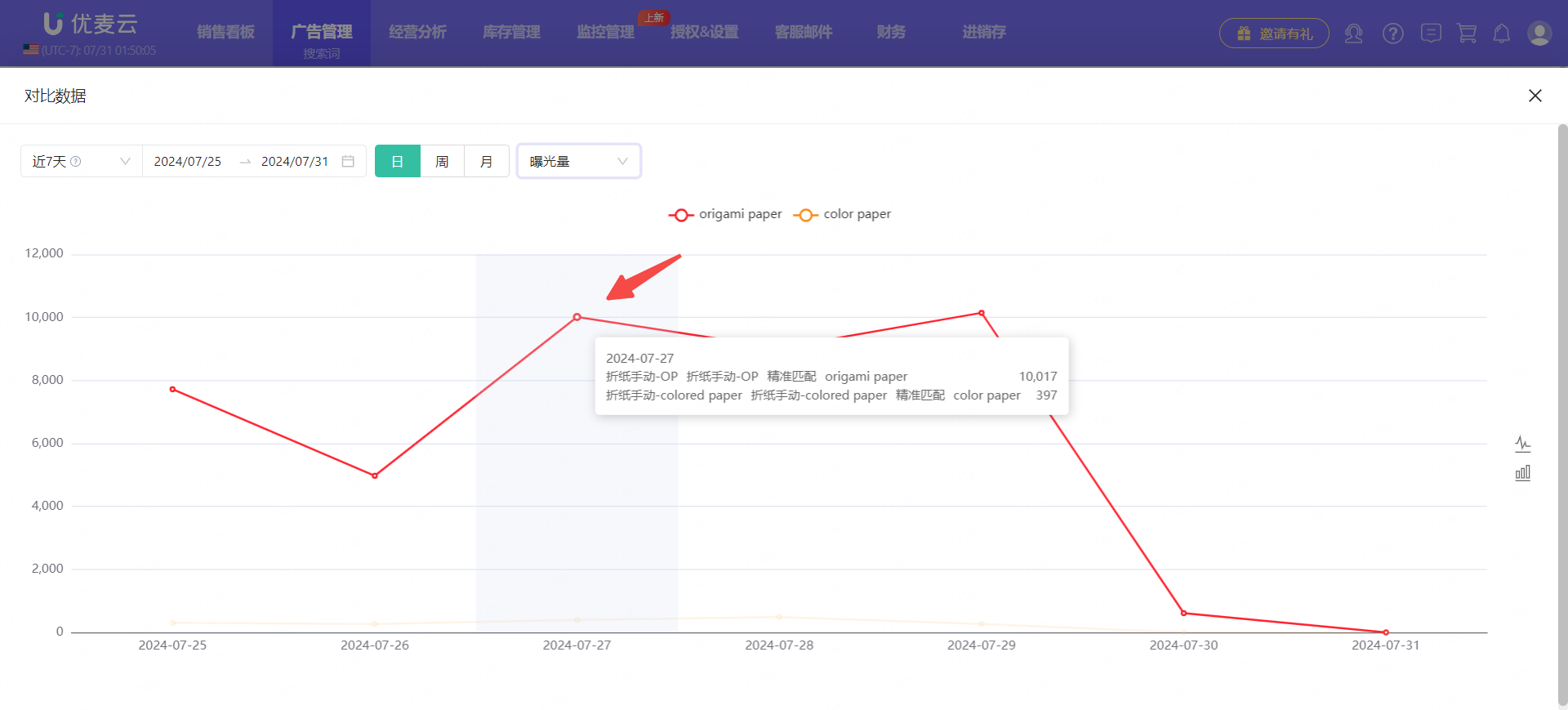 +
+
Click the ad campaign name to hide the data of the ad. Click again to restore the display.
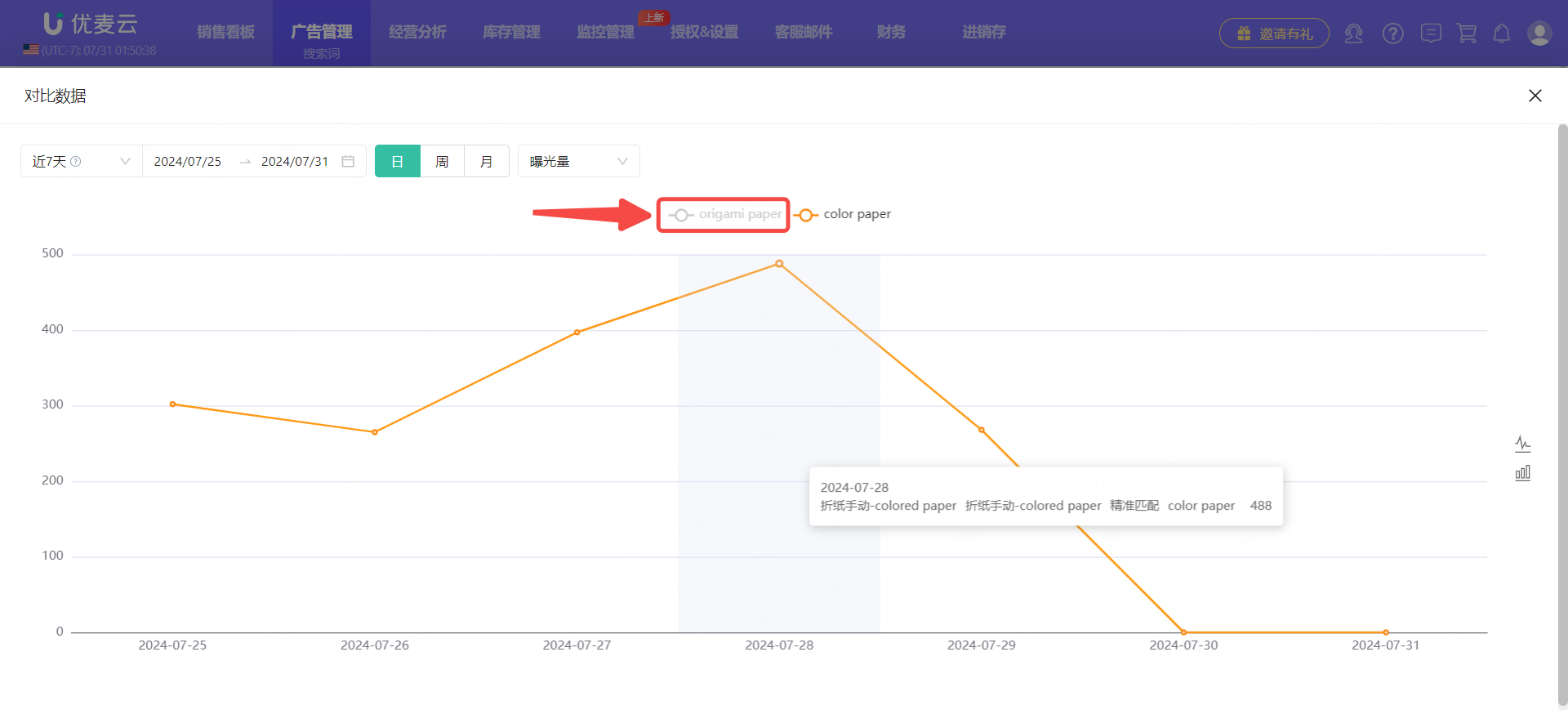 +
+
1.13 Set Tags
Before viewing and analyzing the performance of advertising keywords, we can set tags in advance to classify and manage the targeted keywords, which is convenient for us to quickly find and analyze.
There are two ways to set tags: add individually + add in batches.
Individual adding method: Find the keyword to be tagged, click 【+】 under the "Tag" metric, enter the tag, or select an existing tag to add.
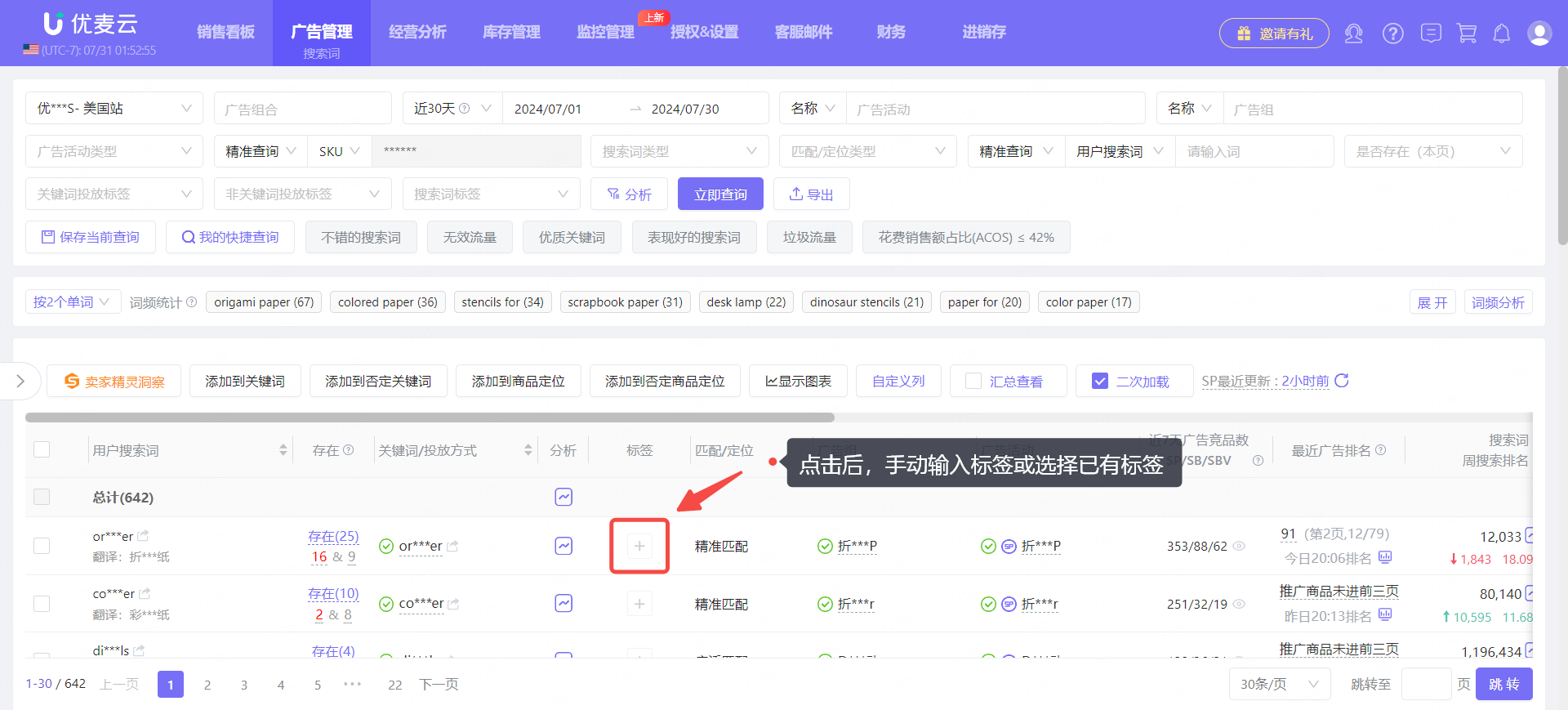 +
+
Batch adding method: Check all ad campaigns to be tagged, click 【Set Tags】, and then enter or select existing tags in the pop-up window, and then click 【Confirm】 to save.
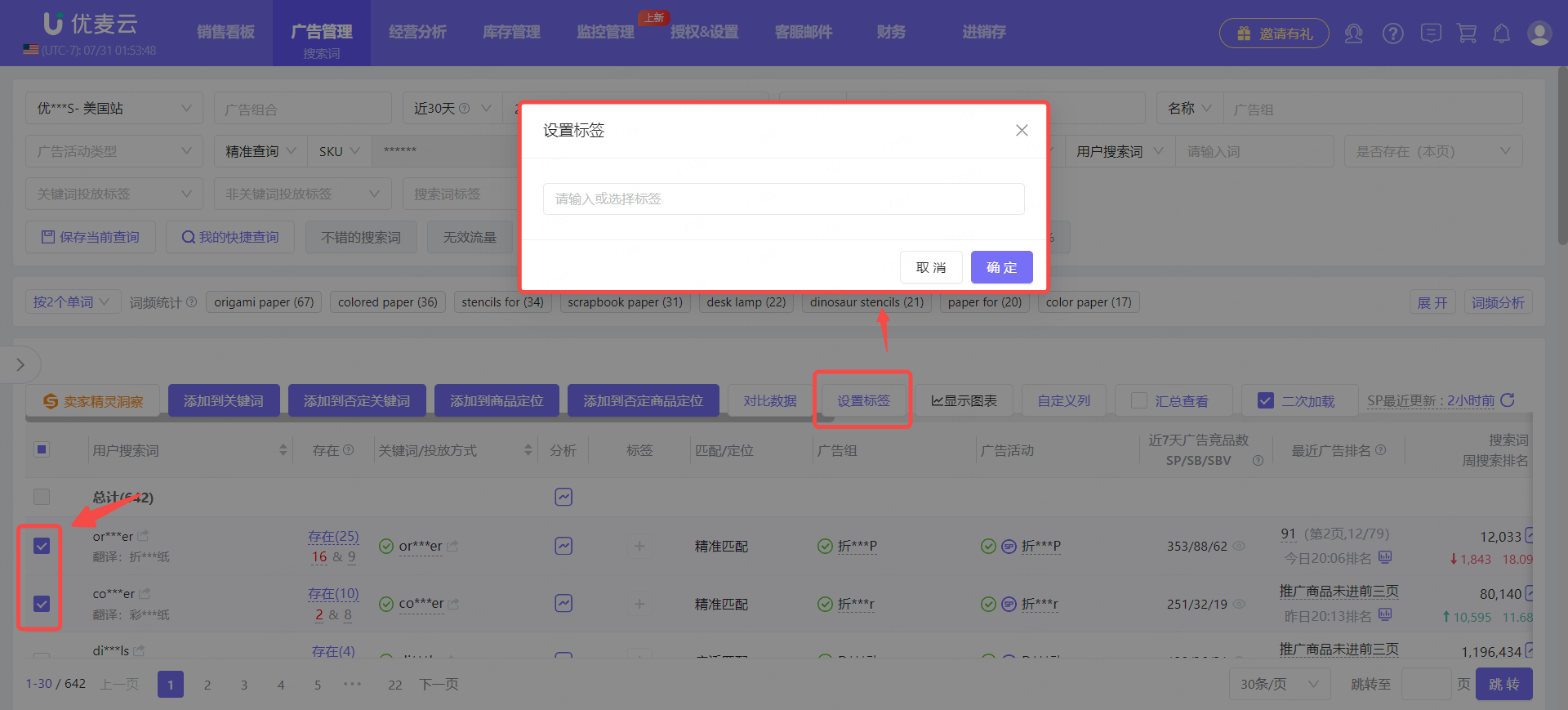 +
+
1.14 Summary View
In addition to filtering and viewing the performance of a single search term, we can also summarize and view the overall performance of all the same search terms according to "Search Term".
Check 【Summary View】 to query with one click.
 +
+
Click the expand button on the left side of the search term to view the performance of the search term in different ad campaigns and ad groups.
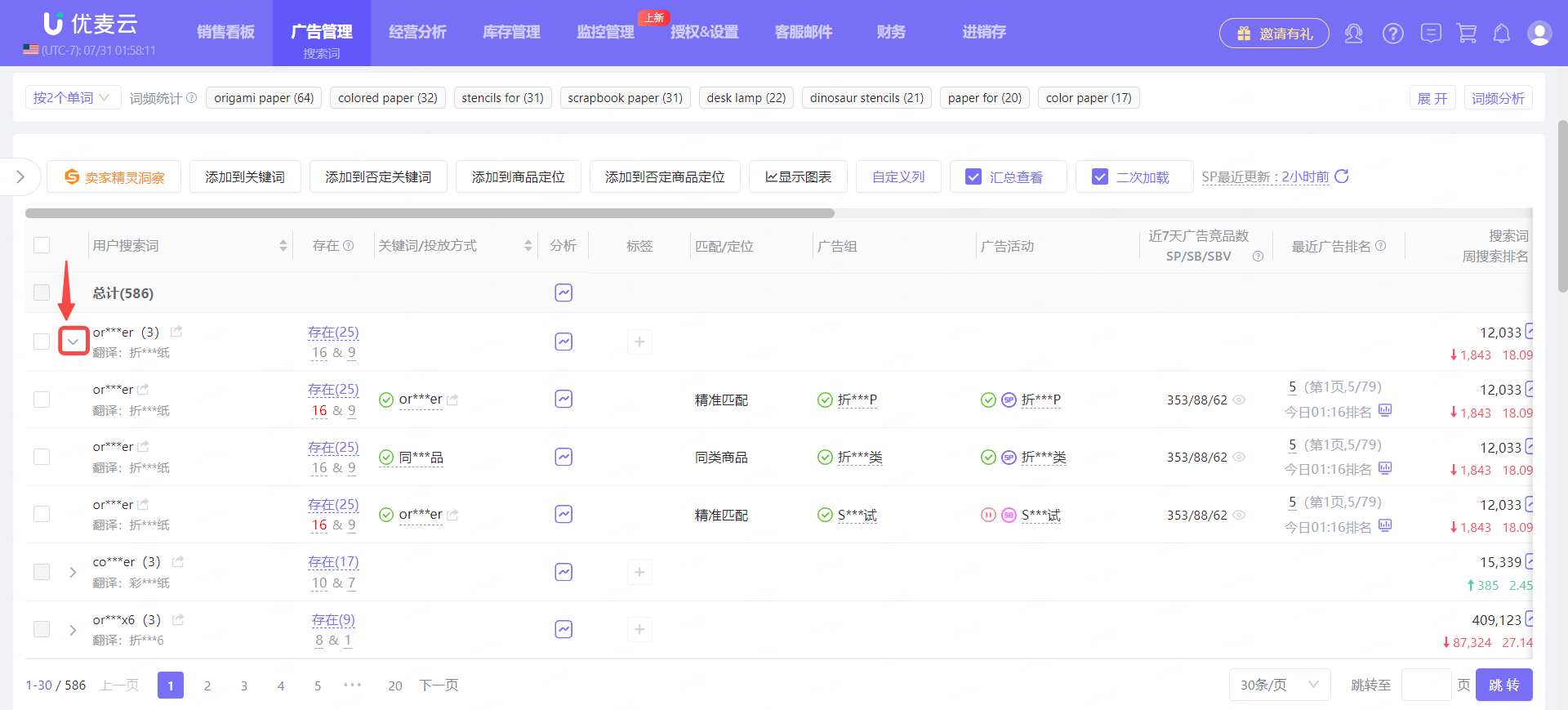 +
+
1.15 Secondary Loading
Secondary loading refers to the advertising data on the current page being loaded in two times. The first time only loads basic advertising data, and then requests to obtain: keyword translation, ASIN pictures, existence, number of ad competitors in the last 7 days, weekly search term rank, impression share and rank data.
If checked, all data will be loaded in two times. If not checked, only metric data other than the secondary loading object will be requested.
 +
+
2. How to Use Search Terms Well
We know how to conveniently and quickly find search terms. How to use search term report data well?
① Analyze the Correctness of Listing Keywords
When we upload new products for the first time, we find many keywords to embed in the listing, but we may not be sure whether these words are appropriate. At this time, we can open automatic campaigns, and then use search term reports to help us assist in judging. Generally speaking, the more relevant the terms that run out, the more it shows that you have found the right words.
We recommend that if you only want to judge the correctness of keywords, it is recommended to analyze after about a week when data comes out. If it is not appropriate, you can replace the words in time to avoid missing
Take the search terms of the origami new product: B0B1MK8X7C, automatic campaign: Origami Automatic - EM as an example. This ad campaign only has one promoted product: ASIN: B0B1MK8X7C, and it has been running for a full week, but.
Enter the search term feature, and find the search terms matched by the ad campaign by searching for the ad campaign name: Origami Automatic - EM.
 +
+
After finding them, we can carefully view the search term data and analyze from the meaning of the words first. We can see that the search terms of this ad campaign are all words related to origami, and there are basically no irrelevant words, indicating that the keywords embedded in the product listing are relatively correct.
 +
+
In addition to viewing the meaning of words, we can also analyze the number and performance of search terms to help judge whether the keywords we embed are correct and sufficient.
If the number of search terms is still small when all four match types of automatic campaigns are fully enabled, it may be that the keywords we provide are not enough, resulting in limited matching, or they are inaccurate, and the Amazon system cannot judge.
 +
+
If there are enough search terms, but the ad performance is poor, such as low impressions, low clicks, low conversion or no conversion, then we can also check whether the listing keywords are accurate enough.
 +
+
② Filter out High-Quality Search Terms
We can filter out high-quality keywords through the search term feature, target ads or embed them in listings.
Before filtering, we must first clarify the characteristics of high-quality keywords. High-quality words meet:
High Impressions + High Clicks + High Conversion + Low CPC + Low ACOS.
Enter the search term feature, select the last 30 days, ad type: Sponsored Products (or Sponsored Brands), search term type: Keywords, and you can directly view the search terms matched by all Sponsored Products ads in the store in the last 30 days.
Tip: You can also filter other conditions to find the high-quality keywords you want.
 +
+
After finding them, we can first get a general understanding of the overall data performance of these search terms by sorting metrics.
Click impression, click, CTR, spend, conversion rate and other related metrics respectively, sort in descending order, and view which search terms are in the top ranks;
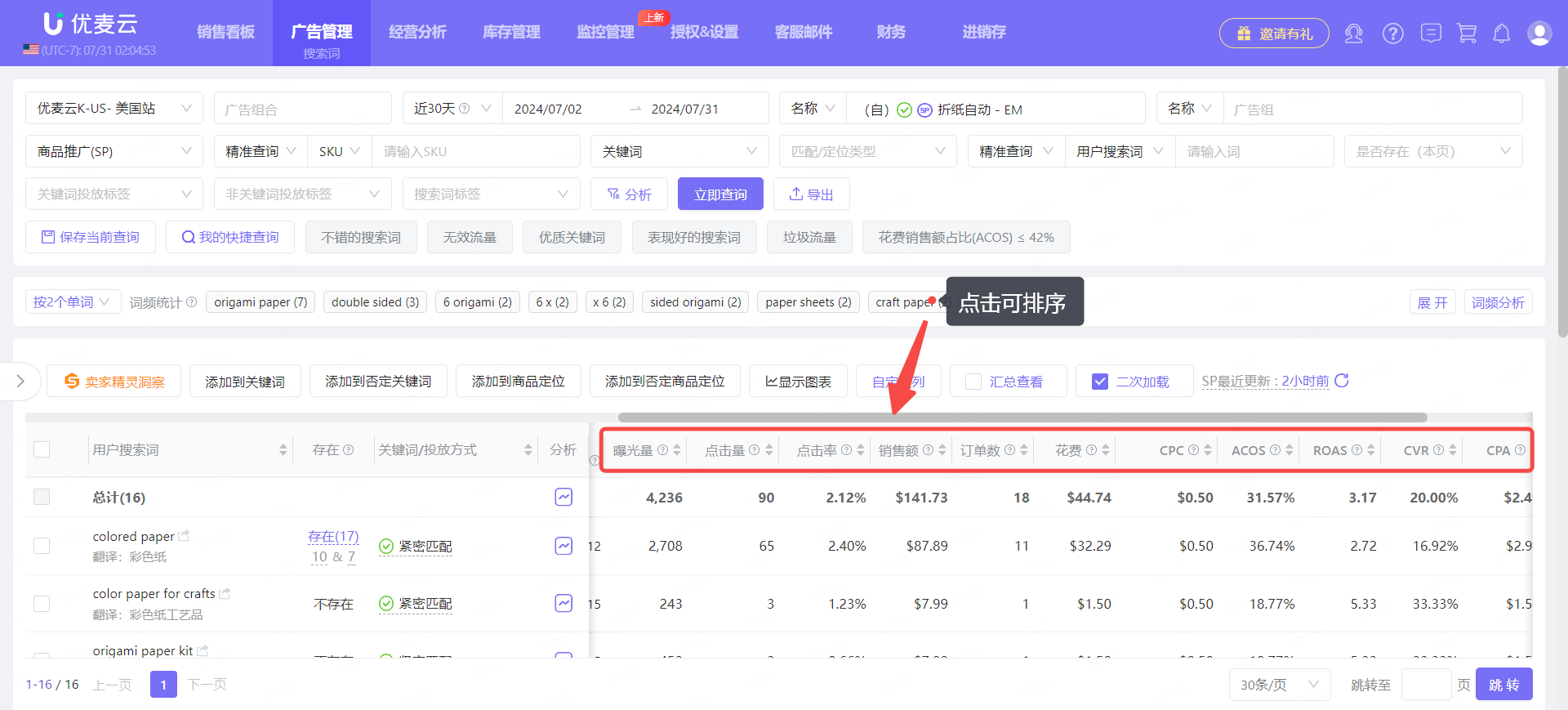 +
+
After having a certain grasp of the overall campaign performance data, click the small funnel icon, and then further refine the data range according to the campaign metrics to accurately find;
 +
+
 +
+
According to the above operations, we can directly find high-quality keywords in the search term report, embed them in the title, bullet points, and Search Term to obtain more accurate natural matching traffic.
At the same time, we can also confirm whether they are already being targeted in ads. If they do not exist, we can directly add the search term to ad targeting to get more traffic and conversions.
Click the filter condition 【Existence (This Page)】, and select 【Non-existence (This Page)】.
 +
+
In fact, in addition to finding more high-quality words related to our products, search term reports can also help us discover some loopholes in our daily operations during filtering and analysis, such as:
Is the product price reasonable? Can the product picture attract traffic? Are the keywords accurate? etc., to help us fill in gaps and improve sales!
③ Conveniently Target or Negate Search Terms
After we view and analyze the search terms, we can directly add the search terms to ad campaigns for ad targeting, or directly add negative targeting.
Add to Keyword Targeting
Select the user search terms you want to add, click 【Add to Keywords】 to enter the settings page;
 +
+
Enter the "Add Search Terms to Keywords" page,
First, select the match type to be targeted.
After selection, the keyword targeting settings for the match type will be generated accordingly.
 +
+
Then, select the ad campaign and ad group to be added to.
We can choose to add search terms to different ad groups. Just select individually.
Click 【+】 on the right to add keywords of this match type to different ad groups.
 +
+
If you want to directly add search terms to the same ad group, you can check 【Batch target in the specified keyword targeting ad group】, and then select the corresponding ad campaign and ad group, which will be automatically filled in below.
Note that if it is specified targeting, it does not support adding keywords of the same match type to another ad group.
 +
+
Then, set the bid for keyword targeting.
There are 2 types of bid settings: individual setting + batch setting
① Individually Set Bid
Click the bid input box on the right and enter directly.
If you want to refer to the suggested bid to set, you can click 【Get】 or 【Get Suggested Bids with One Click】 in the upper right corner to view the Amazon suggested bid for the keyword under the corresponding match type.
 +
+
② Batch Set Bids
Batch setting bids is very flexible. We can directly set all keywords uniformly according to the suggested bid, increasing or decreasing by a fixed value or percentage, or set some bids first, and then uniformly set the bids of the remaining keywords.
Click 【Batch Set Bids】 to enter the settings page.
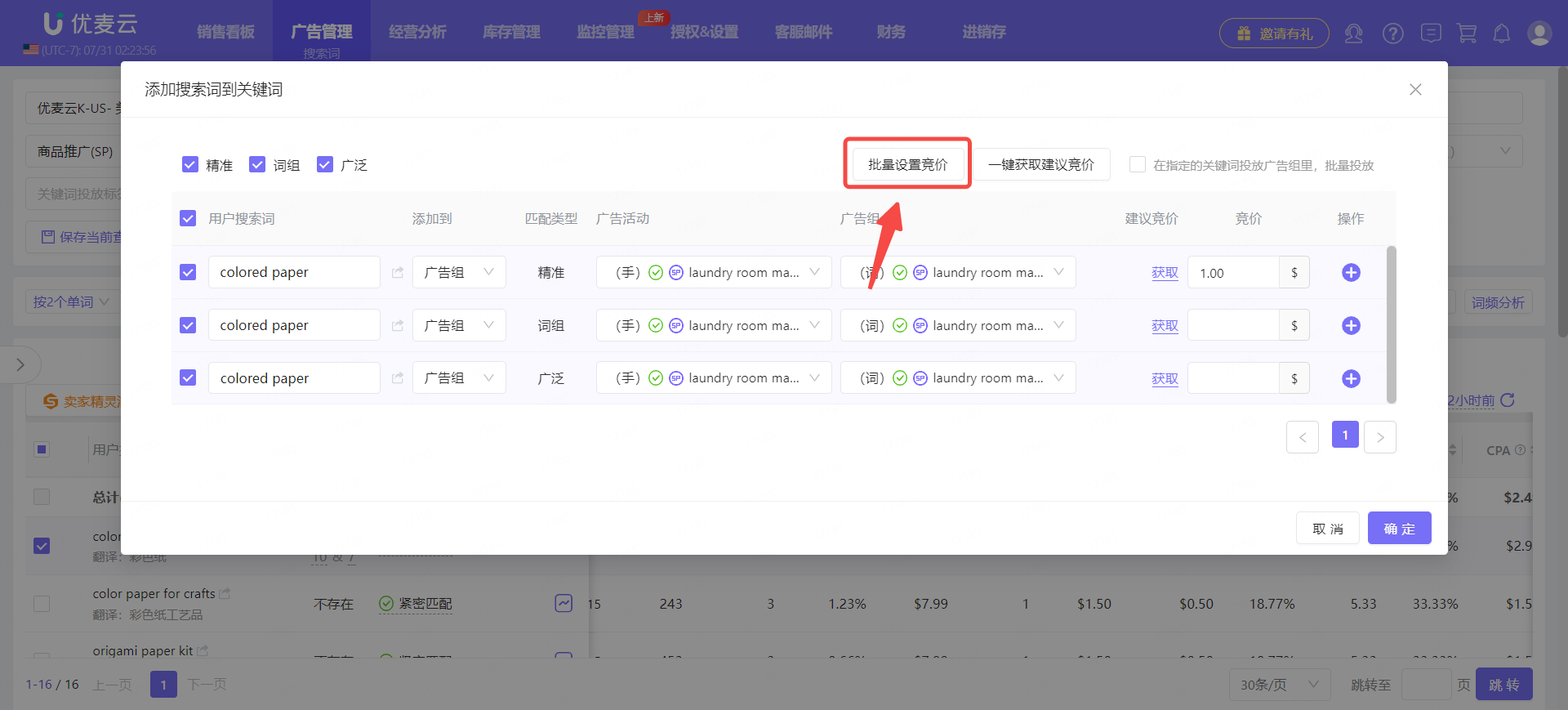 +
+
Enter the "Batch Set Bids" page,
Select and set according to your needs.
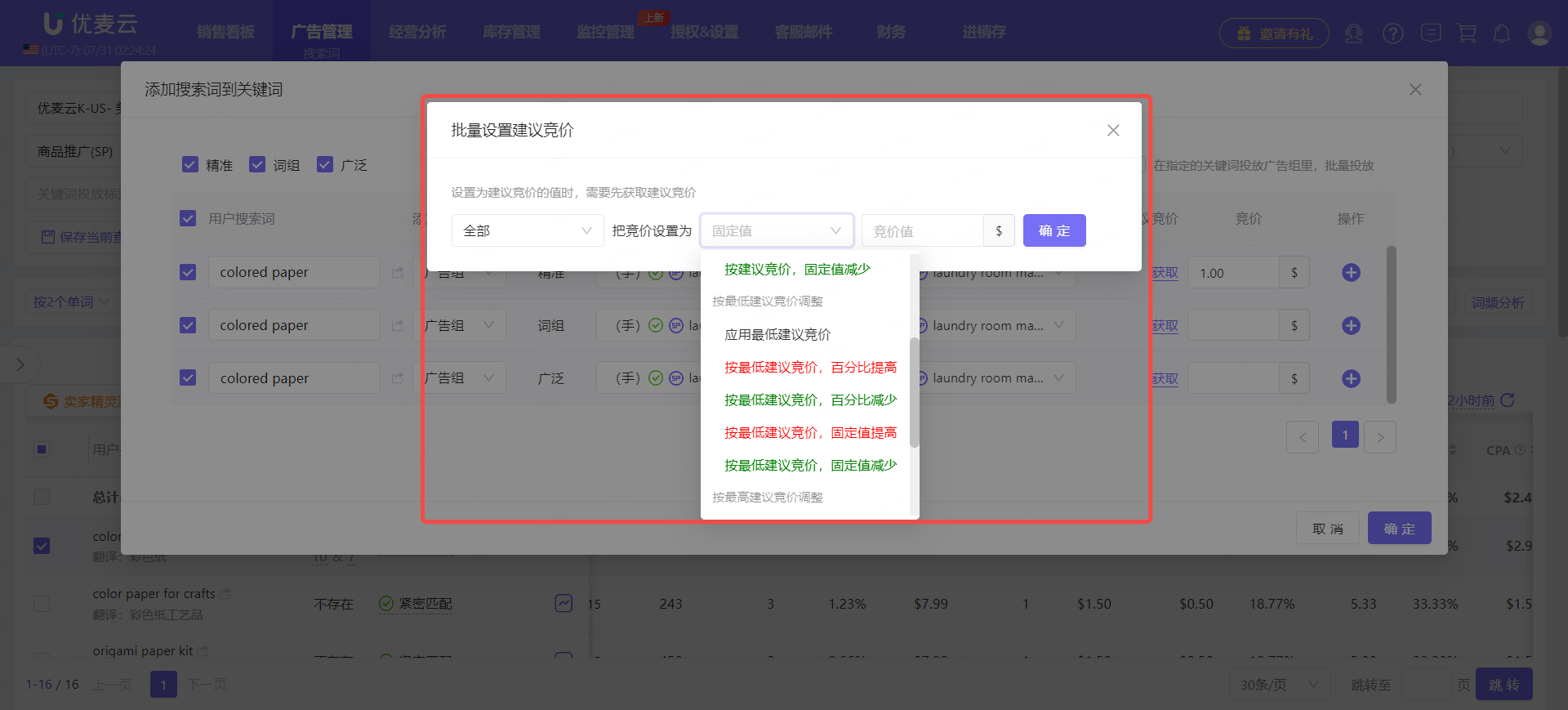 +
+
Finally, confirm that all information is correct and click 【Confirm】 to save.
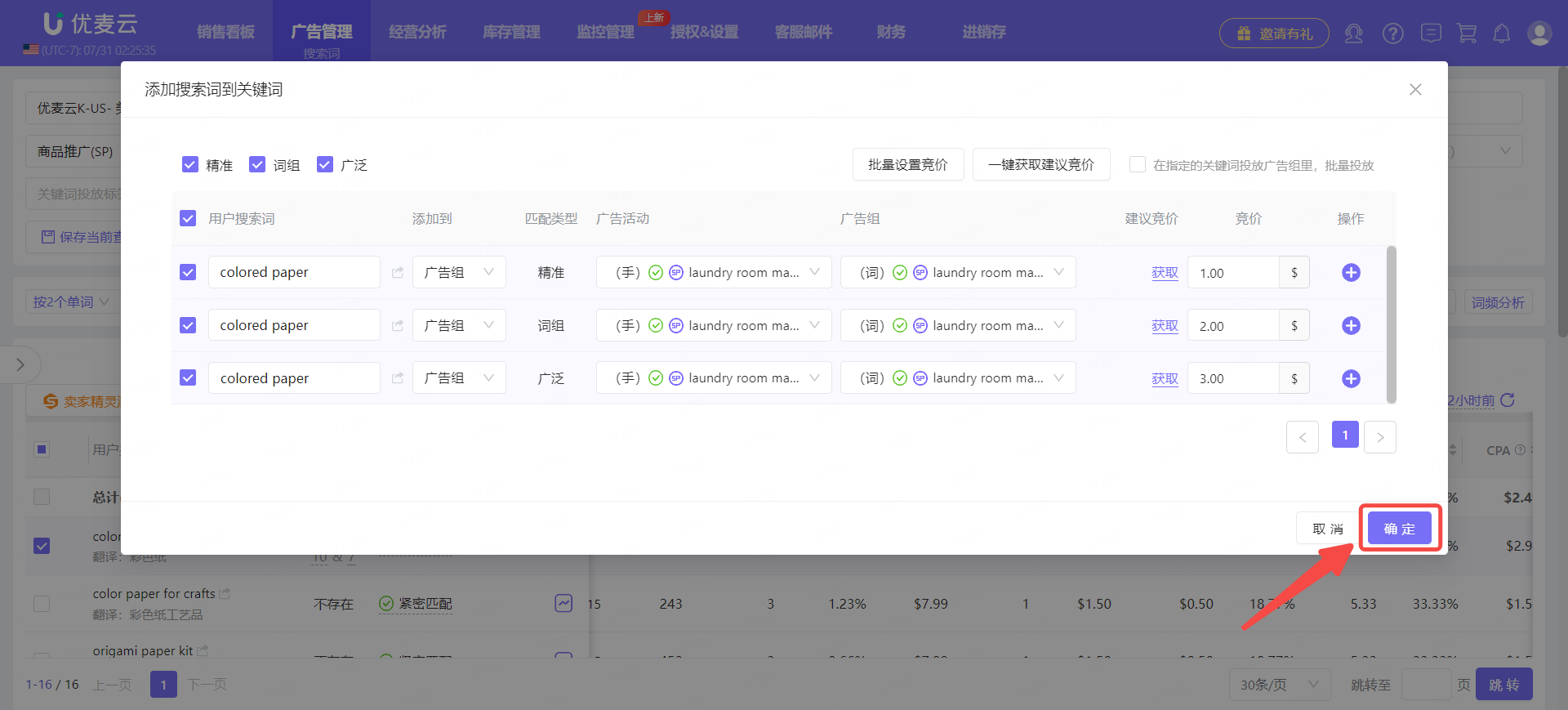 +
+
Add to Negative Keywords
Select the keywords to be added, click 【Add to Negative Keywords】 to enter the settings page;
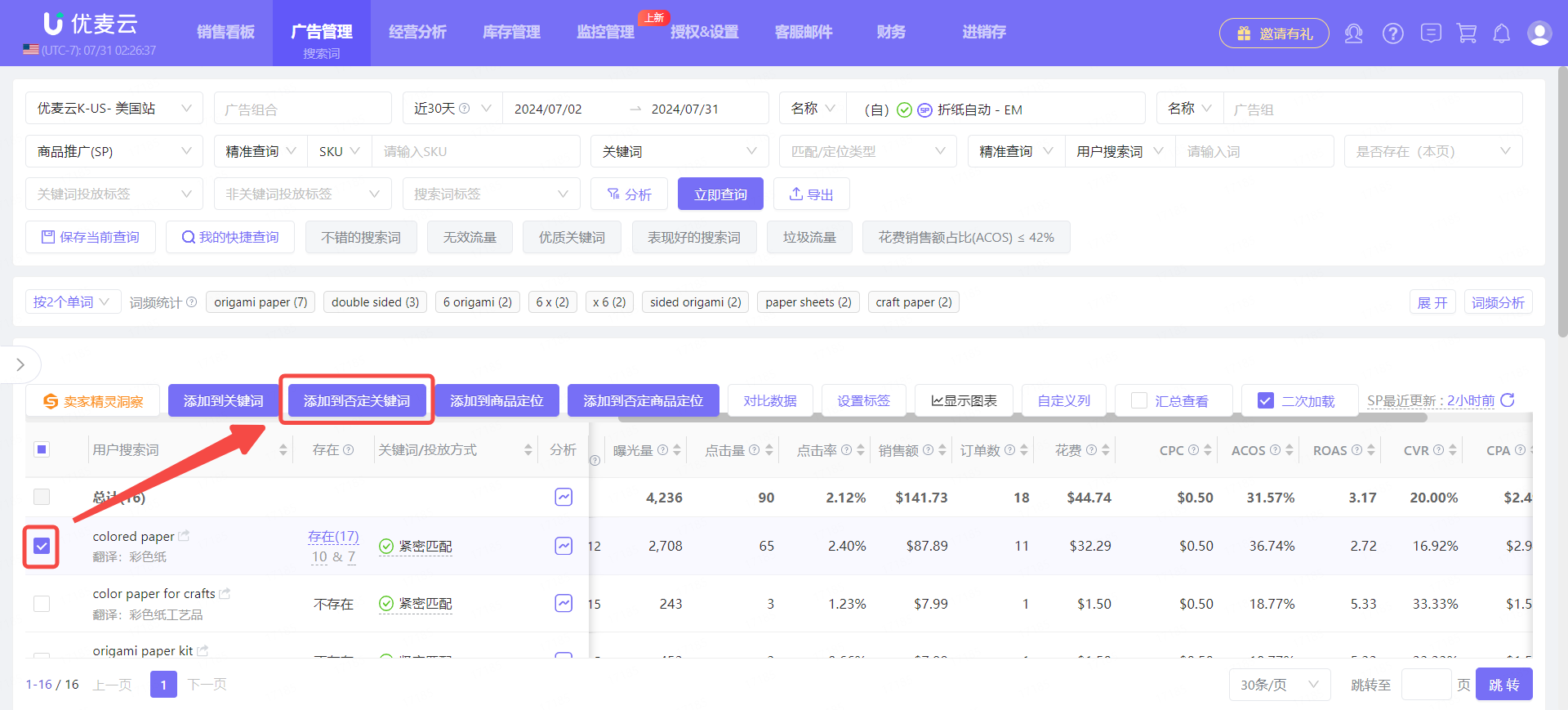 +
+
Enter the "Add Search Terms to Negative Keywords" page,
First, select the match type to be negatively targeted.
After selection, the negative targeting settings for the match type will be automatically checked in batches.
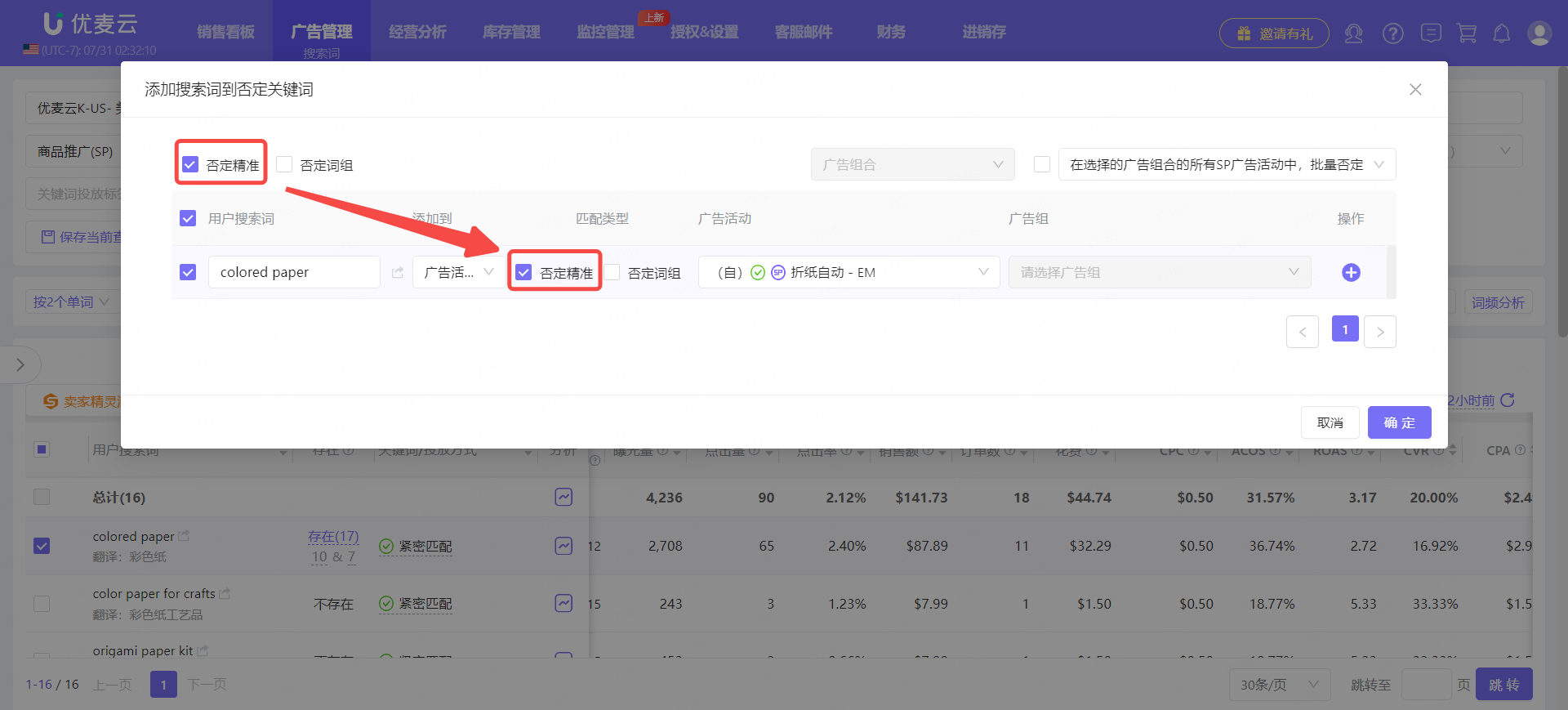 +
+
Then, select the ad campaign and ad group to add negative targeting to.
We can choose to add search terms to different ad campaigns and ad groups. Just select individually.
Click 【+】 on the right to add keywords of this match type to different ad campaigns and ad groups for negative targeting.
 +
+
If we have created ad portfolios, we can also directly add negative targeting to the entire ad portfolio.
When adding negative keywords, check 【Negate in all SP ad campaigns of the selected ad portfolio】, and then select the corresponding ad portfolio.
 +
+
Add to Product Targeting
Enter the ad campaign/ad group name, or directly select product targeting ad campaigns and ad groups from the drop-down box, or filter out the corresponding associated ASIN data through other product targeting related search conditions, or manually enter ASINs, etc.
 +
+
Select the ASIN to be added, click 【Add to Product Targeting】 to enter the settings page;
 +
+
Enter the settings page,
Select the match type; select the ad campaign and corresponding ad group to be added to; get Amazon suggested bids; set ad bids for them separately; or batch add to an ad group, etc. The operation method is basically the same as 【Add to Keywords】.
 +
+
Add to Negative Product Targeting
Select the ASIN to be negatively targeted, click 【Add to Negative Product Targeting】 to enter the settings page;
 +
+
Select to add the ASIN to an ad campaign or ad group, and at the same time select the specific ad campaign or ad group to add. The operation method is basically the same as 【Add to Negative Keywords】.
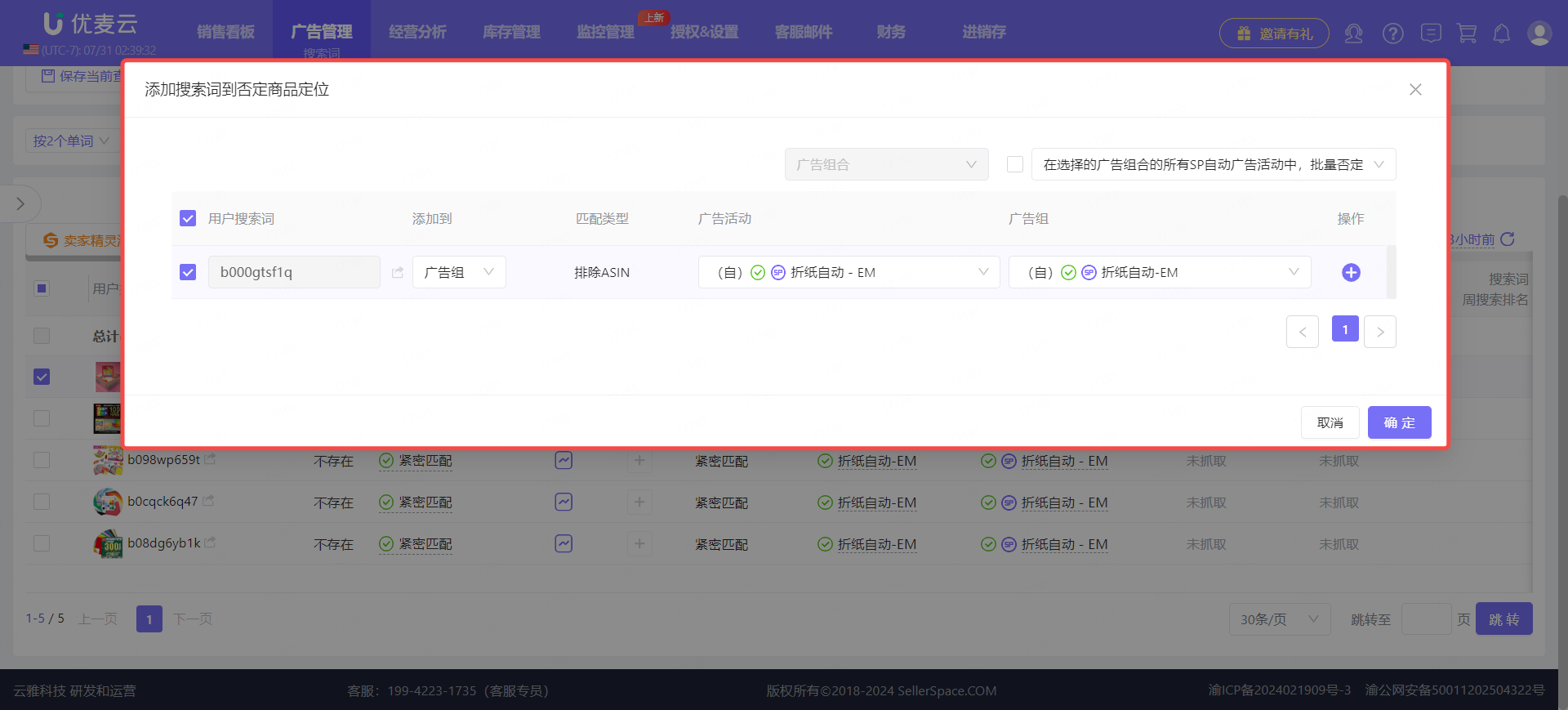 +
+





